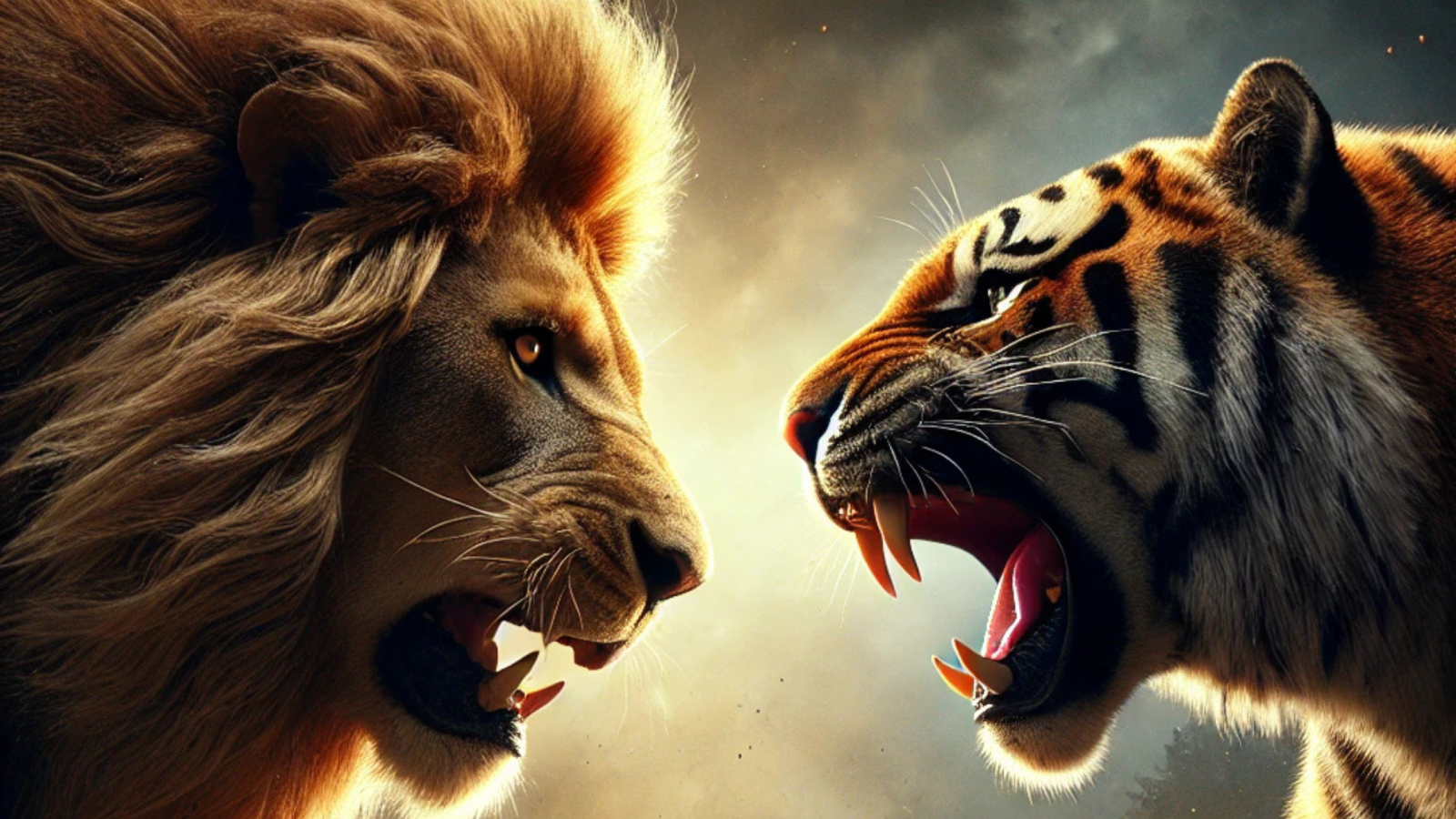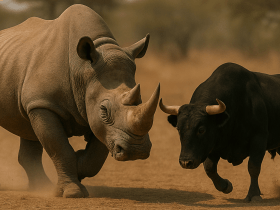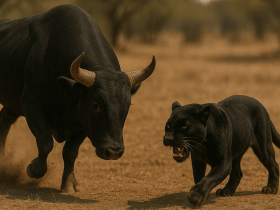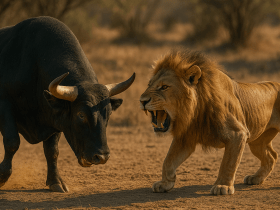Below is a full detailed article about Lion Vs Tiger?
African lion (Panthera leo)
Bengal or Siberian tiger (Panthera tigris)
Below tables cover 10 main topics by including all the numerical and scientifical data by comparing Lion Vs Tiger . Also I have included a winner column for further understanding,
Hope you will enjoy!
1. Body Specifications
| Feature | Lion (Panthera leo) | Tiger (Panthera tigris) | Winner |
|---|---|---|---|
| Height at Shoulder | 1.1–1.2 m | 0.9–1.1 m | Lion |
| Body Length (head-body) | 1.6–2.1 m | 2.4–3.3 m | Tiger |
| Weight | 150–225 kg (male) | 180–320 kg (male) | Tiger |
| Muscle Mass | Dense | Denser, especially forelimbs | Tiger |
| Bone Density | High | Extremely high | Tie |
| Body Shape | Barrel-chested, lean | Robust, muscular | Tiger |
| Skull Size | Smaller, rounded | Larger, broader | Tiger |
| Neck Thickness | Moderate | Thick and muscular | Tiger |
| Tail Length | 70–100 cm | 90–110 cm | Tiger |
| Claw Size | ~3.8 cm | ~4.0 cm | Tiger |
Winner: Tiger — Larger, stronger, and more muscular.
2. Coat and Coloration
| Feature | Lion | Tiger | Winner |
|---|---|---|---|
| Fur Color | Tawny to golden | Orange with black stripes | Tiger |
| Pattern | Uniform | Striped camouflage | Tiger |
| Function | Heat reflection in savanna | Jungle camouflage | Tiger |
| Mane Presence | Yes (males) | No | Lion |
| Mane Function | Protection, intimidation | N/A | Lion |
| Shedding | Seasonal | Seasonal | Tie |
| Camouflage Efficacy | Poor in jungle | Excellent in forest | Tiger |
| Skin Thickness | Moderate | Thick | Tiger |
| Hair Texture | Coarse | Thick, soft | Tie |
| Color Variants | Rare (white lions) | Common (white tigers) | Tiger |
Winner: Tiger — Better adapted for camouflage and ambush.
3. Habitat and Range – Lion Vs Tiger
| Feature | Lion | Tiger | Winner |
|---|---|---|---|
| Primary Habitat | Grassland, savanna | Forests, wetlands | Tie |
| Geographic Range | Sub-Saharan Africa | Asia (India, Russia, SE Asia) | Tie |
| Temperature Tolerance | High | Extreme cold (Siberian) to tropical | Tiger |
| Habitat Flexibility | Moderate | High | Tiger |
| Territorial Range | 20–400 km² | 60–1,000 km² | Tiger |
| Human Proximity Tolerance | Low | Moderate | Tiger |
| Elevation Tolerance | Up to 2,000 m | Up to 3,000 m | Tiger |
| Shelter Type | Bushes, rocky outcrops | Caves, dense cover | Tiger |
| Range Shrinkage | High | Very high | Tie |
| Conflict with Humans | Frequent | Frequent | Tie |
Winner: Tiger — More versatile across habitats.
4. Diet and Hunting
| Feature | Lion | Tiger | Winner |
|---|---|---|---|
| Diet Type | Carnivore | Carnivore | Tie |
| Preferred Prey | Wildebeest, buffalo | Deer, boar, gaur | Tie |
| Hunting Strategy | Cooperative (pride) | Solo ambush | Tiger |
| Kill Method | Neck bite, suffocation | Neck/spine bite, stealth | Tiger |
| Success Rate (solo) | 18–25% | 30–50% | Tiger |
| Daily Caloric Needs | ~6,000–7,000 kcal | ~5,000–6,000 kcal | Tie |
| Kill Size Limit | Up to 600 kg | Up to 900 kg (gaur) | Tiger |
| Caching Behavior | Rare | Yes, may drag kill | Tiger |
| Hunting Time | Dawn/dusk | Night | Tiger |
| Feeding Behavior | Hierarchical | Territorial | Tie |
Winner: Tiger — Superior solo hunter with higher success rate.
5. Strength and Bite Force
| Feature | Lion | Tiger | Winner |
|---|---|---|---|
| Bite Force | ~650 PSI | ~1,050 PSI | Tiger |
| Claw Force | Strong | Very strong | Tiger |
| Paw Swipe Force | Moderate | Very high (can break bones) | Tiger |
| Neck Strength | High | Higher | Tiger |
| Jaw Size | Smaller | Larger | Tiger |
| Skull Thickness | Moderate | Thick | Tiger |
| Muscle Distribution | Balanced | Forelimb-dominant | Tiger |
| Wrestling Ability | Excellent | Superior | Tiger |
| Killing Efficiency | Group effort | One-shot ambush | Tiger |
| Endurance Power | Moderate | High | Tiger |
Winner: Tiger — Raw power and bite superiority.
6. Speed and Agility – Lion Vs Tiger
| Feature | Lion | Tiger | Winner |
|---|---|---|---|
| Top Speed | 80 km/h | 65 km/h | Lion |
| Acceleration | Very fast | Fast | Lion |
| Stamina | Short bursts | Slightly longer bursts | Tiger |
| Agility (land) | Good | Excellent | Tiger |
| Agility (water) | Poor | Strong swimmer | Tiger |
| Jumping Distance | ~11 m | ~10 m | Lion |
| Balance | Moderate | Superior | Tiger |
| Turning Radius | Wide | Tighter | Tiger |
| Tree Climbing | Rare | Capable | Tiger |
| Stealth Ability | Moderate | Exceptional | Tiger |
Winner: Tiger — Although lions are faster in short bursts, tigers are more agile, stealthy, and versatile.
7. Senses – Lion Vs Tiger
| Feature | Lion | Tiger | Winner |
|---|---|---|---|
| Vision (Day) | Good | Excellent | Tiger |
| Vision (Night) | Excellent | Excellent | Tie |
| Olfactory Senses | Strong | Strong | Tie |
| Hearing Range | Up to 60 kHz | Up to 65 kHz | Tiger |
| Sensory Whiskers | Present | Present | Tie |
| Environmental Awareness | Good | Excellent | Tiger |
| Vomeronasal Organ | Present | Present | Tie |
| Sound Localization | Very good | Exceptional | Tiger |
| Long-Range Detection | Moderate | Better | Tiger |
| Sensory Adaptability | Fixed | Highly adaptable | Tiger |
Winner: Tiger — Slightly superior senses give the tiger an edge in hunting and combat.
8. Reproduction and Lifespan
| Feature | Lion | Tiger | Winner |
|---|---|---|---|
| Gestation Period | 110 days | 105–112 days | Tie |
| Litter Size | 1–4 cubs | 2–4 cubs | Tie |
| Sexual Maturity (Male) | 3 years | 3.5–4 years | Lion |
| Cub Mortality Rate | Up to 80% | Up to 50% | Tiger |
| Parental Care | Pride-shared | Solitary mother | Tiger |
| Breeding Frequency | Every 2 years | Every 2–3 years | Tie |
| Weaning Age | 6–7 months | 5–6 months | Tiger |
| Dispersal Age | 2–3 years | 2 years | Tiger |
| Lifespan (Wild) | 10–14 years | 10–15 years | Tiger |
| Lifespan (Captivity) | 20–25 years | 20–26 years | Tie |
Winner: Tiger — Better cub survival rates and slightly longer wild lifespan.
9. Social Behavior – Lion Vs Tiger
| Feature | Lion | Tiger | Winner |
|---|---|---|---|
| Social Structure | Pride-based | Solitary | Lion |
| Territory Defense | Group defense | Solo defense | Tie |
| Communication | Roars, scent, grooming | Roars, scent, scratching | Tie |
| Cooperative Hunting | Yes | No | Lion |
| Dominance Hierarchy | Strict | None | Lion |
| Cub Rearing | Communal | Maternal only | Lion |
| Territorial Marking | Urine, roar | Urine, scratch, roar | Tie |
| Conflict Resolution | Within pride | Avoidant | Lion |
| Coalitions | Yes (male alliances) | No | Lion |
| Social Intelligence | High | Moderate | Lion |
Winner: Lion — As social animals, lions show more complex group behavior and cooperation.
10. Conservation Status
| Feature | Lion | Tiger | Winner |
|---|---|---|---|
| IUCN Status | Vulnerable | Endangered | Lion |
| Population Estimate | ~20,000 (wild) | ~4,500 (wild) | Lion |
| Population Trend | Decreasing | Decreasing | Tie |
| Habitat Loss | Severe | Extreme | Tie |
| Poaching Risk | Medium | Very High | Lion |
| Conservation Programs | Multiple | Extensive, global | Tie |
| Protected Areas | Many in Africa | Many in Asia | Tie |
| Captive Breeding | Common | Very common | Tie |
| Genetic Diversity | Declining | Low | Lion |
| Conflict with Humans | High | Very High | Lion |
Winner: Lion — Less endangered and with higher population numbers.
⚔️ Face-to-Face Fight: Who Would Win?
In a one-on-one confrontation between a Lion Vs Tiger, environment plays a critical role. However, in neutral territory—say, a large forest clearing or enclosed arena—tigers generally dominate in direct confrontations.
Historical records from Roman times, Indian princely fights, and even modern zoo enclosures have repeatedly shown tigers overpowering lions due to the following:
-
Superior strength and muscle mass
-
More powerful bite and swipe
-
Greater agility and stamina
-
Solo hunting experience
-
Killer instinct in one-on-one battles
While lions are courageous, cooperative, and formidable within a pride, a tiger’s solitary fighting style gives it the upper hand in duels.
Face-to-Face Fight Winner: Tiger
Final Verdict: Overall Winner of Lion vs Tiger
| Category | Winner |
|---|---|
| Body Specifications | Tiger |
| Coat and Coloration | Tiger |
| Habitat and Range | Tiger |
| Diet and Hunting | Tiger |
| Strength and Bite Force | Tiger |
| Speed and Agility | Tiger |
| Senses | Tiger |
| Reproduction & Lifespan | Tiger |
| Social Behavior | Lion |
| Conservation Status | Lion |
✅ Final Score: Tiger – 8 | Lion – 2
Why Tiger Wins
-
Larger body, stronger bite, and superior muscle mass
-
Expert solo hunter trained in ambush and quick kills
-
Greater agility, stealth, and combat adaptability
-
Higher one-on-one combat efficiency
-
Domination in most recorded confrontations
Why Lion Loses
-
Relies heavily on group dynamics
-
Lacks the same raw strength and agility
-
Lower bite force and less combat experience in solo fights
When Do the lions win?
I should mention that in some cases when it comes to face to face fight, Lions never give-up, They got brave souls which ultimately leads them to fight till the death. On the other hand Tigers are not Doing battles till the death, So when Tigers got wounded, they are avoiding The Fight. With this view Lions are winning.
Read More – Tiger Vs Jaguar vs Lions
References
- IUCN Red List
- National Geographic
- Smithsonian’s National Zoo
- Journal of Mammalogy
- Wildlife Conservation Society






Leave a Reply